From time to time I'll run across a discussion on Facebook, reddit, in a forum, or elsewhere, that seeks to answer the question, Why play in Greyhawk? The question is often presented in contrast to another setting---"Why play in Greyhawk instead of the Forgotten Realms?" or Planescape, or Ravenloft, or whatever---or as part of a general poll about settings you like. A recent reddit discussion about favorite settings prompted me to write this post.
I have offered many responses to similar questions about how and why I love Greyhawk as a setting, and I've shared some over the years:
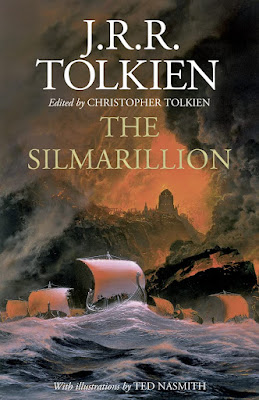 |
The Silmarillion,
by J.R.R. Tolkien |
All that said, over the holiday break while re-reading the second edition of Tolkien's The Silmarillion, in the introduction I ran across a quotation from one of Tolkien's letters that helps to explain some of what I love most about Greyhawk (page xii; my emphases):
I [JRRT] had a mind to make a body of more or less connected legend, ranging from the large and cosmogonic, to the level of romantic fairy-story---the larger founded on the lesser in contact with the earth, the lesser drawing splendour from the vast backcloths... I would draw some of the great tales in fullness, and leave many only placed in the scheme, and sketched. The cycles should be linked to a majestic whole, and yet leave scope for other minds and hands, wielding paint and music and drama.
The quotation is famous among Tolkien fans and scholars, and inspired the titles for two different zines devoted to MERP gaming and Tolkien scholarship. It also echoes in spirit and tone, if not specific language, three of the key features that I love most about the Greyhawk setting:
- Greyhawk as a sandbox campaign setting
- Greyhawk as a place of adventure inspiration and expansion
- Greyhawk's fan community helps to keep the spirit of Greyhawk alive and relevant to today's gamers
Greyhawk as a Campaign Sandbox: Two Takes
A significant volume of Greyhawk-related lore has been published over the decades in official sources from TSR and WotC, and in unofficial content from both its original creators Gary Gygax, Rob Kuntz, and Lenard Lakofka (to name just a few), as well as from its many dedicated fans. For a sampling of such 1e Greyhawk content see Adrian Newman's TSR Archive site and for a more-comprehensive listing see Echohawk's Greyhawk Collector's Guide.
All that said, Greyhawk
still offers "room to grow" in the baseline versions of the setting published
over the years, particularly so in the Greyhawk Folio (1980) and 1983 Greyhawk Boxed Set versions. By that, I mean that Greyhawk paints its details with a broad brush, that leaves room for you as the DM and the players adventuring in Oerth to finely detail the setting in your individual campaigns. This is particularly true compared to other settings that have been heavily detailed in both gaming products and in novels, like The Forgotten Realms or Dragonlance. Later versions of the setting of also support this mode of expansive creativity, simply with more backstory and history behind their "present day" in the setting.
For example, In Darlene's 576 Common Year Greyhawk map there is not much going on near the southern mouth of the Nesser River, so when Henry and I decided to start up a solo aquatic AD&D campaign for him, we set it there, knowing that there wouldn't be too much potential for conflict with existing Greyhawk content:
 |
grodog's sketch map
for Greyhawk hex L3-94 |
 |
grodog's Greyhawk
hex L3-94 with labels |
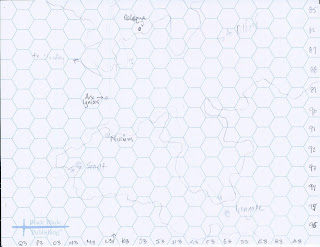 |
| grodog's Relaqua regional sketch map |
 |
Relaqua materials
for aquatic AD&D campaigning |
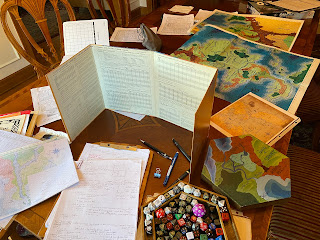 |
Relaqua materials
for aquatic AD&D campaigning |
While we were a little off in our "blank canvas" assessment---since I am not as deeply familiar with many 2e Greyhawk books, and WGR4 The Marklands created a new town named Nessermouth near to where we sited our Relaqua game---we're still happy to build out our version of the region as we desire, the Marklands notwithstanding ;)
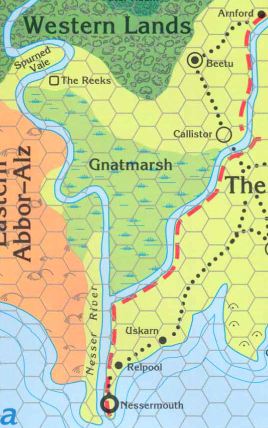 |
Ninja'd!--the Nessermouth and
Gnatmarsh region,
from WGR4 The Marklands |
A multitude of these "blank canvas" areas in Greyhawk exist across eras and editions, where you can start a game and begin to explore the world, one bit at a time. Each of Darlene's Greyhawk map hexes is scaled to 30 miles across, so each offers plenty of room to build out your own version of Greyhawk, even within "known" hexes where towns, cities, and dungeons have predefined locations.
In this second example, I shift gears a bit into how Greyhawk has slowly evolved as a sandbox setting over its decades of development. Gygax seeded this twice-told rumor in the 1980 Greyhawk Folio, in the entries for The Wild Coast and the Suss Forest:
Tales relate that somewhere within the Suss there exists a lost city of the Old Suloise--from which the Jewel River gained its name. It has never been found, and the legend is highly doubtful (Folio page 19).
and
A lost, ruined city of of the Old Suloise is said to be hidden somewhere in the Suss forest, but few dare to venture on such a quest, particularly today (Folio page 26).
 |
Artifact of Evil,
original artwork by Clyde Caldwell
|
While the same rumors exist in the 1983 Greyhawk Boxed Set, Gary later described this lost city in his novel Artifact of Evil, although it was never detailed fully for play as a published module (and is nicely summarized by Krista Siren in her Gord's Greyhawk site).
This group was to pierce the trackless tangles of the heart of the Suss Forest, find a lost ruin there, recover a bit of some strange and occult object of eldritch origin, and carry it safely into the hands of those who fought against Evil. (page 73)
On the east bank of the Jewel, Curley Greenleaf finally broke out his secret information. It was a reproduction of an ancient map that crudely depicted the area they were in at a time long past. This drawing showed that there was a city just a few miles---as far as they could determine, anyway---north of their present position.
From what they could determine, they had to be within a few miles of their goal, only the ruin of the ancient city did not seem to exist. Many things were possible, but entire cities did not just disappear.... Perhaps the whole thing was a fable.... Perhaps, but with but with so much evidence at hand, albeit information of cryptic sort, that seemed doubtful, (pages 78-79)
Legend had said a city of the Suloise had been here, but this place was certainly of origination predating the migration of the Invoked Devestation by centuries! (page 83)
Versions of Greyhawk published after the Folio and Boxed Set built upon these foundations, sometimes resolving mysteries initially left for DMs to define on their own. Later works also introduced new wonders and legends into the setting, some of which, in turn, were explored in the next generations of products. Carl Sargent's From the Ashes (1992) seeded the idea of the Star Cairns as a collection of lost tombs within the Cairn Hills; they were later built-out as The Star Cairns adventure in "The Lost Tombs" triology of modules during the 1998 Greyhawk revival. Tenser's castle---The Fortress of Unknown Depths, first described by Gygax in WG6 Isle of the Ape---was sketched in passing the City of Greyhawk boxed set in 1992, and further enriched by Carl Sargent in Ivid the Undying before being built-out by Roger Moore in 1998's Return of the Eight. The Isles of Woe were first mentioned in Eldritch Wizardry in 1976 in the artifact description for The Codex of the Infinite Planes, and were visited (I think for the first time), in the "Ether Threat" series of Living Greyhawk adventures back in 2002. Countless additional examples exist. These successive layers of accumulating lore keep Greyhawk fresh, and offer new opportunities for adventure. They also showcase the unique stamp that each generation of designers and fans imprint on the setting.
These changes to the setting over time keep Greyhawk alive as a vibrant, freewheeeling sandbox: some of its lore is contradictory, while some is couched in terms to suggest that it's not accurate ("the legend is highly doubtful"). This "Greyhawk Uncertainty Principle" empower DMs with the freedom to choose the versions of a legend or story they prefer, to relocate legends and dungeons elsewhere in the Flanaess, and to disregard and hack the discrepancies in canon compeltely when it suits the demands of their campaigns.
Greyhawk as a Place of Inspiring and Expanding Adventures
Many adventures provide DMs and players with years of gaming inspiration and fun at the table. In
many cases, they are truly modular, and can be incorporated into any
era of Greyhawk, played with any edition (with some conversion, of
course), and migrated to published settings like the Forgotten Realms or
into homebrew worlds unknown outside of those who dice together around
its table. The Greyhawk modules deisgned by Gary Gygax, Rob Kuntz, Lenard Lakofka, David A. Cook, Carl Sargent, Erik Mona, Roger E. Moore, and many other designers are no exception.
But Greyhawk's best adventures, like the setting itself, intentionally build design room for the DM and players to expand upon the baseline templates provided between their covers. I see this in particular in the Giants and Drow series of six modules (G1-3 and D1-3), the paired S4 Lost Caverns of Tsojcanth and WG4 Forgotten Temple of Tharizdun, and WG5 Mordenkainen's Fantastic Adventure, but this principle holds in many other modules as well. These adventures sketch foundations and also provide expansion points that inspire Dungeon Masters to design further: to build next steps, to layer in additional lore and detail, to add another level to what already exists. To echo Tolkien's quotation above---to wield pen and ink and personal creativity within the frameworks initially shaped by other minds and by other hands. To image and render possibility, drama, and adventure unimagined but encouraged by Greyhawk's best designs.
G1 Steading of the Hill Giant Chief offers lost temples and collapsed corridors that beg to be cleared out to reveal new levels to plumb. The drowic underworld of D1 Descent into the Depths of the Earth charts the narrow path that leads to Erelhei Cinlu, but sketches a wider Underoerth that can include Carl Sargent's Night Below and Wolfgang Baur's Empire of the Ghouls (Open Design 2007) as desired. Erik Mona's "Whispering Cairn" (Dungeon Magazine #124) is revisited and later expanded in Wolfgang Baur's "A Gathering of Winds" (Dungeon #129). The Garden of the Plantmaster (Creations Unlimited 1988) connects both to Castle Greyhawk (where it originated) and to WG5's Lost City of the Elders , which Kuntz later shared in his El Raja Key Archive (TLB Games 2016). Roger Moore's Return of the Eight mentions a hidden moon base laboratory used by Iggwilv and Tenser. And so on.
The wheel turns, and the plots mature. Endangered Greyhawk calls its defenders to muster.
Will you answer the call?
The call to adventure.
The Fan Community Sustains Greyhawk
Oerth Journal #37 nears publication and its launch will mark 28 years of fan-published support for the setting.*
The Greyhawk Wiki didn't exist during the heyday of the Greytalk and Greyhawk-L email listservs in the 1990s and the Living Greyhawk era.
Jason Zavoda's wonderful Encyclopedia Greyhawkiana Index spans both eras of fandom: rooted in the Greytalk era, it has blossomed through a modern redeployment in both wiki and Excel forms. (For more detail, see my Greyhawk Links page notes).
Discord supports Greyhawk discussion and gaming across a variety of servers:
reddit has dedicated channels for both Greyhawk and AD&D. Twitch livestreams, YouTube channels, and podcasts champion and explore Greyhawk. Blogs and forums offer deeper dives and keep the old Greytalk Archives alive even after they vanished into the deep ethereal of Lotus Notes hell decades ago. (For more detail, see my Greyhawk Links page notes).
The community of Greyhawk fans have rallied around the setting and kept it alive when its corporate overlords thought they had put the final bullet between its eyes.
Greyhawk thrives during this decentralized, Fandom Renasissance, and its fans keep Greyhawk as relevant today in 2023 at it was in 1973.
Greyhawk fans are tenacious, curious, and always willing to lend a hand to help welcome newcomers to the setting.
Adventure beckons.
Join us.
Allan.
==
* Friends of the Oerth Journal Assemble! posted by /u/ArtharntheCleric on 6 Jan 2023:
Greyhawk fans will probably be aware of the Oerth Journal, a "fan" created magazine available in print and on line since 1995 creating new content for Greyhawk. It was originally started to support Greyhawk when TSR was not, and has featured luminaries such as Len Lakofka, Gary Holian, Erik Mona, Roger E Moore, Erik Boyd, etc.
Oerth Journal during COVID migrated from Patreon to Jemi for donations to support its work, and the take up was not 100%. In fact well short of. So the Oerth Journal, with issue 37 due to come out soon (delayed due to injury and illness to editor Kristoph Nolen), needs your support. Kristoph will ensure it gets out, but we'd all prefer he wasn't putting his hand in his own pocket to ensure it does!
If you previously supported the OJ via Patreon but didn't renew when it moved to Jemi, or have enjoyed it before but never supported, or have never checked it out before and are willing, please look at providing support with a one off or regular donation via Jemi here:
https://jemi.so/greyhawkonline
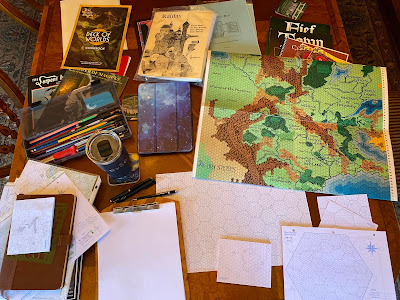














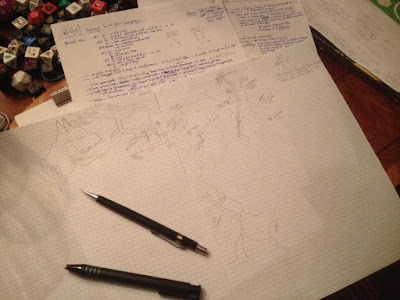
*I'm also not jumping down the rabbit hole of Rob Kuntz's "open forms" book concept yet, but that is a quite possibly an ending point for this analysis, I suppose.